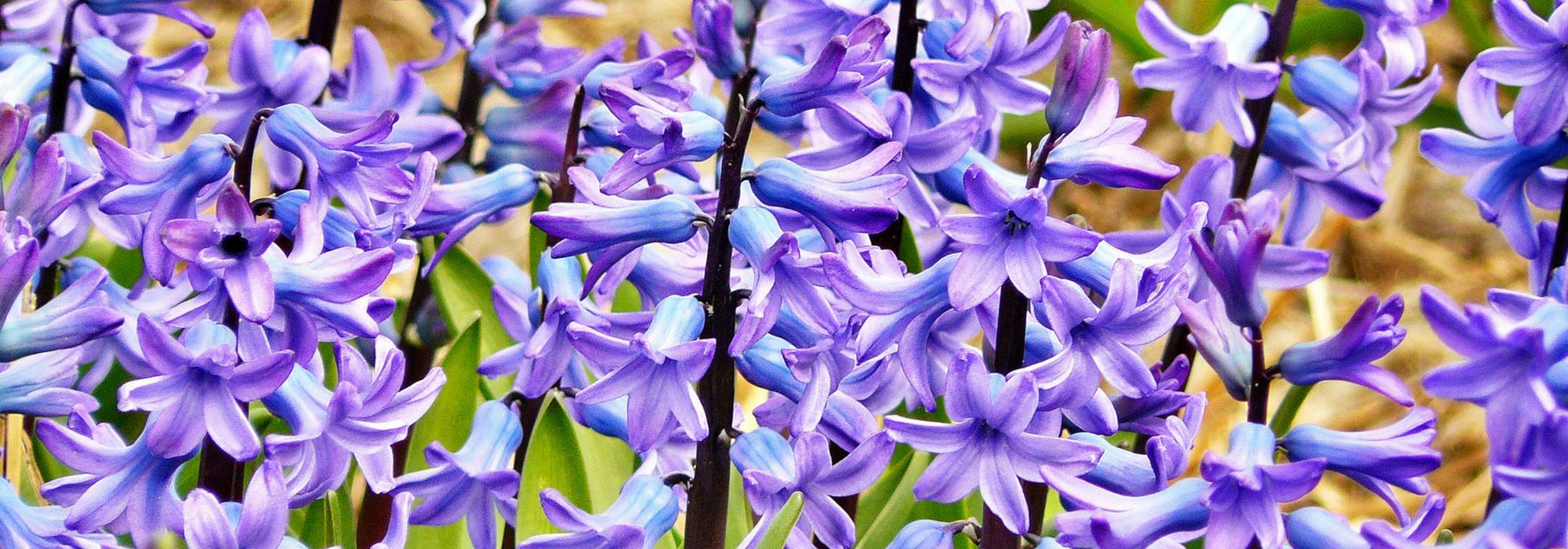
Hyacinth: planting, growing and care
Contents
Hyacinths in a nutshell
- Hyacinths are among the first to flower
- These bulbous plants are highly valued for their penetrating fragrance and their clusters of star-shaped flowers
- They make stunning pots and window boxes
- They can bloom indoors, right in the heart of winter
- Hyacinths are low-maintenance and naturalise in the ground
A word from our expert
In the garden or in pots on a windowsill, hyacinths are a must-have for spring. We eagerly await their tender colours and their fabulous fragrance that herald the end of winter.
Thanks to the forcing of their bulb, hyacinths give us a taste of spring by blooming indoors in the middle of winter. They gracefully adorn our festive tables during the holiday season, and their sweet scent competes for attention with their charming bells.
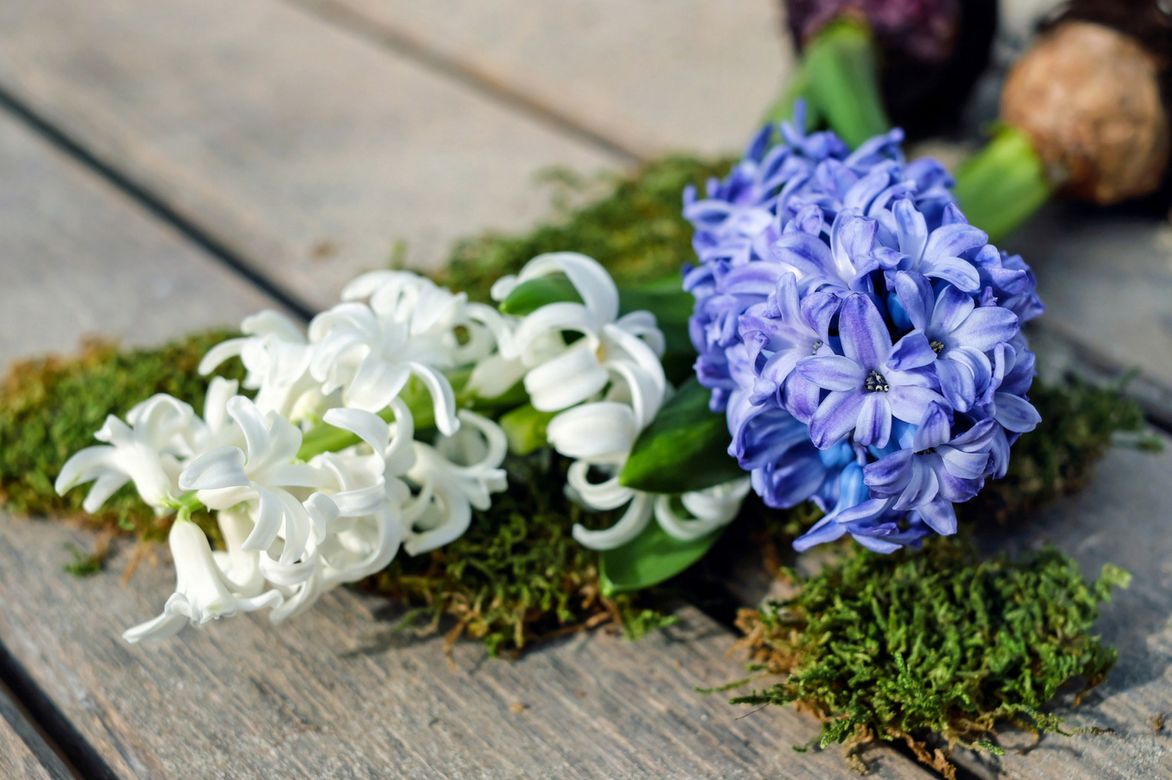
Hyacinth flowers.
Outside, their bulbs are planted in autumn and naturalise without special care. Hyacinths are ideal for the beginner gardener and for those with little time to devote to their garden, as they require very little maintenance.
Hyacinths are essential for fresh and fragrant spring scenes in any type of garden or terrace. In a mix of colours, in shades or monochrome, combined with other bulbs or perennials, they will ensure a spectacular display at the beginning of spring.
Description and Botany
Botanical data
- Latin name Hyacinthus orientalis
- Family Hyacinthaceae/Asparagaceae
- Common name hyacinths
- Flowering March-April (December to February for forced bulbs for indoors)
- Height 30 cm on average (from 20 cm to 40 cm, depending on hybrids)
- Exposure sun or partial shade
- Soil type deep and well-drained
- Hardiness -15 °C
Hyacinths are charming spring bulbous plants forming an upright tuft of linear, bright green foliage that disappears in summer. In March-April, the fleshy flower stem bears numerous bells called florets, with 6 waxy, curved petals, white or blue for wild varieties.
Previously classified under Liliaceae, this plant is now part of the Asparagaceae family. However, some botanists consider them typical enough to be placed in a dedicated family, the Hyacinthaceae.
Native to the Middle East and introduced to France in the 16th century, Hyacinthus orientalis, a slender variety with a soft bouquet of blue flowers, is the source of many hybrids with more abundant flowering spikes known as Dutch hyacinths.
These various cultivars display colours ranging from white to pink and varying shades of purple, as well as orange and yellow. For our delight, the selection has expanded with double-flowered hyacinths such as “Crystal Palace”, more sophisticated and the multiflorous hyacinths, graceful cultivars featuring multiple, finer flower stems with a more natural appearance.
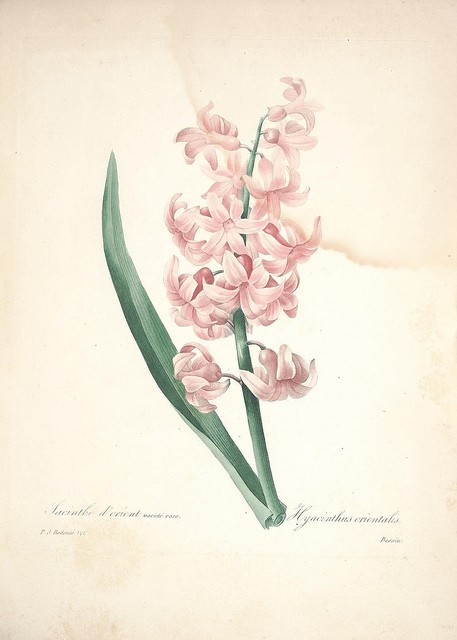
Hyacinthus orientalis – botanical illustration
Any well-drained soil in full sun or light partial shade is suitable and hyacinths require little maintenance: cutting faded flowers ensures a beautiful flowering the following year… and that’s it! They disappear in summer to preserve themselves from drought, and the bulb also withstands winter cold. The cold period triggers the vegetative cycle. This specificity is exploited to allow for early flowering by artificially placing the bulbs at low temperatures, then at a warmer temperature, simulating the transition from winter to spring: this is the forcing of hyacinths. This is how we can bring flowers into our homes in the heart of winter.
Hyacinths offer us a delightfully fragrant flowering in March-April lasting 3 to 4 weeks. It is preferable to leave the foliage until it yellows to replenish the bulbs’ reserves and ensure beautiful future blooms. Perennials will be welcome to hide the wilting.
Finally, the word hyacinth can refer to other plants, whether from the same family or not, that resemble the true hyacinth:
- wild hyacinth or wood hyacinth or Scilla nutans which blooms in woodlands just after hyacinths, in April-May
- the orchid hyacinth or Bletilla striata, a terrestrial orchid flowering in June-July
- the Cape hyacinth, Galtonia candicans and Galtonia viridiflora, South African bulbous plants that bloom in summer
- the water hyacinth or Eichhornia azurea, an Amazonian aquatic plant

Several shapes and colours: Hyacinthus ‘Dark Dimension’, Hyacinthus ‘Blue Eyes’, Hyacinthus ‘Jan Bos’, Hyacinthus multiflora pink, Hyacinthus ‘Woodstock’.
The main varieties of hyacinths

Hyacinthus x orientalis Blue pearl
- Flowering time April, May
- Height at maturity 25 cm

Hyacinthus x orientalis China Pink
- Flowering time April, May
- Height at maturity 25 cm
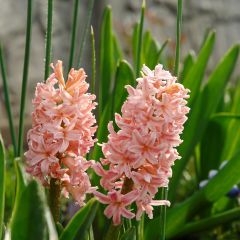
Hyacinthus Gipsy Queen - Garden Hyacinth
- Flowering time May
- Height at maturity 25 cm
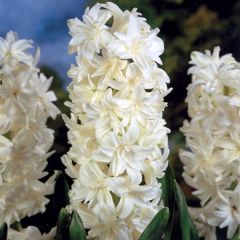
Hyacinthus x orientalis Madame Sophie
- Flowering time April, May
- Height at maturity 30 cm

Hyacinthus x orientalis City of Harleem
- Flowering time May, June
- Height at maturity 30 cm

Hyacinthus x orientalis Multiflora Blue
- Flowering time April, May
- Height at maturity 25 cm

Hyacinthus x orientalis Hollyhock
- Flowering time April, May
- Height at maturity 20 cm

Hyacinthus x orientalis Dark Dimension
- Flowering time April, May
- Height at maturity 25 cm
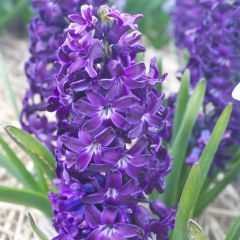
Hyacinthus Blue Magic - Garden Hyacinth
- Flowering time April, May
- Height at maturity 25 cm

Hyacinthus Delft Blue - Garden Hyacinth
- Height at maturity 25 cm
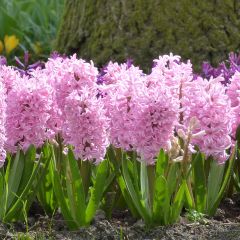
Hyacinthus Fondant Prepared
- Flowering time March, April
- Height at maturity 20 cm

Collection of 30 Hyacinths
- Flowering time April
- Height at maturity 20 cm
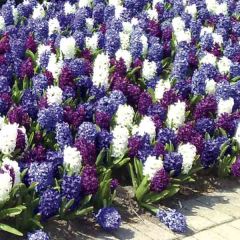
Harmony Hyacinths Ocean
- Flowering time March, April
- Height at maturity 20 cm

Romantic Stroll Collection
- Flowering time May, June
- Height at maturity 30 cm
Discover other Hyacinths
View all →Available in 0 sizes
Available in 0 sizes
Available in 0 sizes
Available in 1 sizes
Available in 0 sizes
Available in 0 sizes
Available in 1 sizes
Available in 1 sizes
Available in 1 sizes
Available in 1 sizes
How to plant hyacinths?
Hyacinths are planted like all spring bulbs. The sheet “planting bulbs” describes in detail all the planting tips.
Where to plant hyacinths?
Hyacinths thrive in well-drained soil. In damp ground, add sand or gravel at planting to improve drainage, which prevents the bulbs from rotting.
Place hyacinths in full sun or light partial shade to optimise flowering. Consider pairing them with later-flowering perennials, such as columbines or masterworts, which will both hide their yellowing foliage during spring and fill the gap created by the bulb entering dormancy.
For indoors, choose a bright spot away from any heat sources: hyacinths bloom as soon as a warm spell occurs, but they will dry out if it gets too hot. By maintaining a cool and homogeneous temperature, no more than 19°C, the flowering will be long and generous.
When to plant?
The best time to plant spring bulbs is from October to early November. If planting is done later, fortunately, it does not affect the survival of hyacinths: flowering will be delayed and the plants will be a bit weak, but in subsequent years, everything will return to normal. Discover the tips on the sheet “how to plant your spring bulbs late”.
→ Planting hyacinths in the ground
Hyacinths are perfect for borders, under bushes, or to awaken a summer bed that is empty at the end of winter. They will settle there for a long time. After the plump spikes of the first years, they will form less opulent but graceful and light stems with a more natural appearance. To plant your hyacinths in the garden:
- Dig a planting hole. Add coarse sand to make the soil more draining,
- Place the bulb, point facing upwards, 8 to 10 cm deep and 15 to 20 cm apart,
- Cover with a mixture of soil and one-third potting soil, then water lightly to settle.
→ Planting hyacinths in pots
Due to their small size, hyacinths are among the preferred plants for window boxes. Their fabulous fragrance will be much more appreciated on a windowsill, within nose reach! To plant your hyacinths in pots:
- Place gravel or broken pot pieces to ensure drainage,
- Fill with potting soil,
- Plant the bulbs about ten centimetres deep,
- Water to settle the soil.
For a beautiful and original spring pot, don’t hesitate to plant several bulbs of different genera one above the other: this is the method of lasagne bulbs.
Hyacinths are traditionally used to flower indoors at Christmas. To learn more, visit our article: “Christmas Hyacinth: how to force it and make it bloom”
Caring for hyacinths
Hyacinths are not demanding, but you can cut the faded flowers to prolong the flowering. This action also prevents the formation of seeds that weaken the bulb, thus ensuring a beautiful flowering the following year.
Hyacinth bulbs can withstand temperatures down to -15°C in well-drained soil. For regions with milder winters, lift the bulbs after the leaves have wilted and store them dry until the following autumn.
An excess of water is harmful to hyacinths, which is why, in pots or containers, it is recommended to water moderately when the substrate is dry.
Diseases and Pests
Rot is the main disease of bulbs and this is most often due to poor drainage: as a preventive measure, take care when planting by choosing well-drained soil. In damp ground, add sand or small gravel at the bottom of the planting hole. Naturally, moderate watering is also advised!
Slugs and snails may be tempted by young shoots… there are several ways to defend against nematodes that you will find in the advice sheet “Slugs: 7 effective ways to fight naturally.”
Hyacinth Propagation
Sowing is long and uncertain, and it is preferable to collect the bulbets present around the edges of hyacinth bulbs. Replant them in a pot so they can develop under the best conditions. When they are strong enough, replant these new bulbs in their final position in autumn.
Associations
In the garden, hyacinths are best planted in numbers, as the colourful carpet they create is magnificent! It is always preferable to place them near a pathway to fully enjoy their enchanting fragrance.
At the border, plant hyacinths with ground covers or low perennials that will hide the yellowing foliage of the hyacinth: a compact geranium that flowers in early summer or low heucheras like Heuchera Sweet Tart.
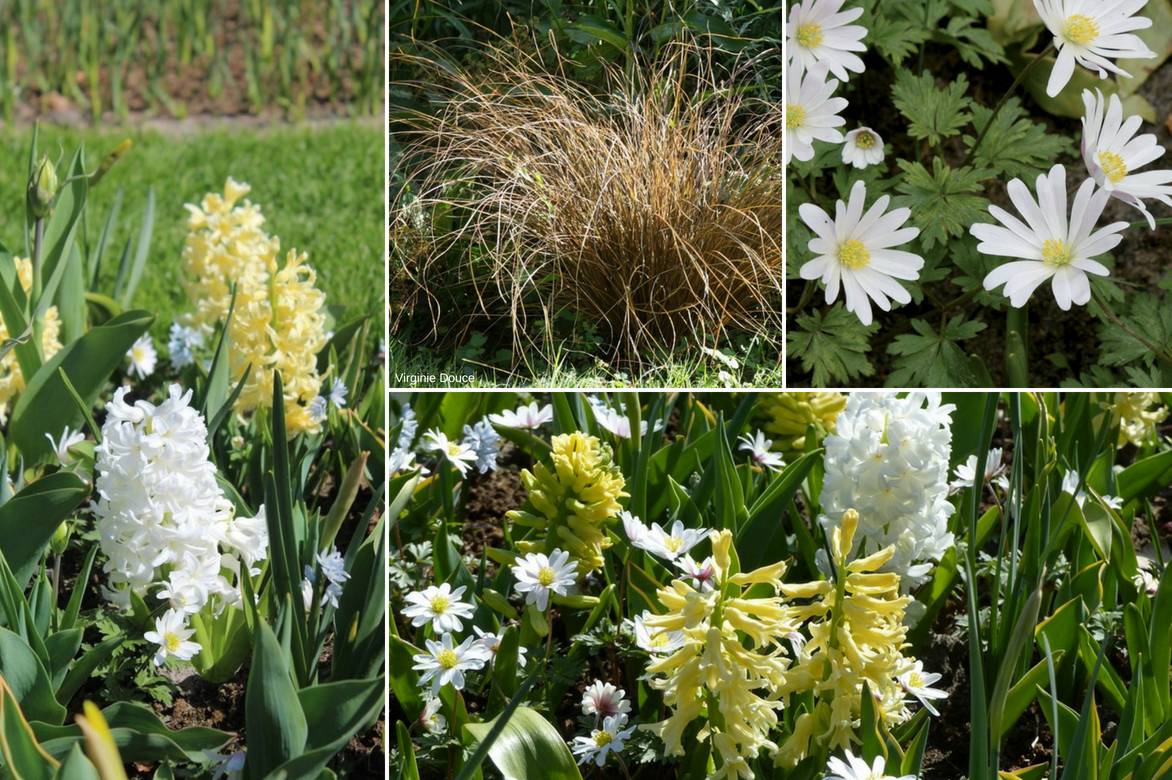
An example of pairing: Yellow hyacinth like ‘City of Harleem’, White hyacinth like ‘Madame Sophie’, Anemone blanda ‘White Splendour’ mixed with some clumps of Carex buchananii.
Carex with subtle tones like Carex oshimensis Everest, or with warm tones of Carex oshimensis Evergold with a soft and light habit contrast beautifully with the opulent spikes of the hyacinths. These small grass/hyacinth scenes can be advantageously transferred to pots or planters.
Consider violas and primroses that will accompany the flowering of the hyacinths. Daffodils and botanical tulips also bloom at the same time and, along with the hyacinths, will joyfully enliven a corner of the garden or terrace.
Don’t forget the spring bulb collections made up of harmonious assortments that can be planted in the garden or in original and fragrant pots.
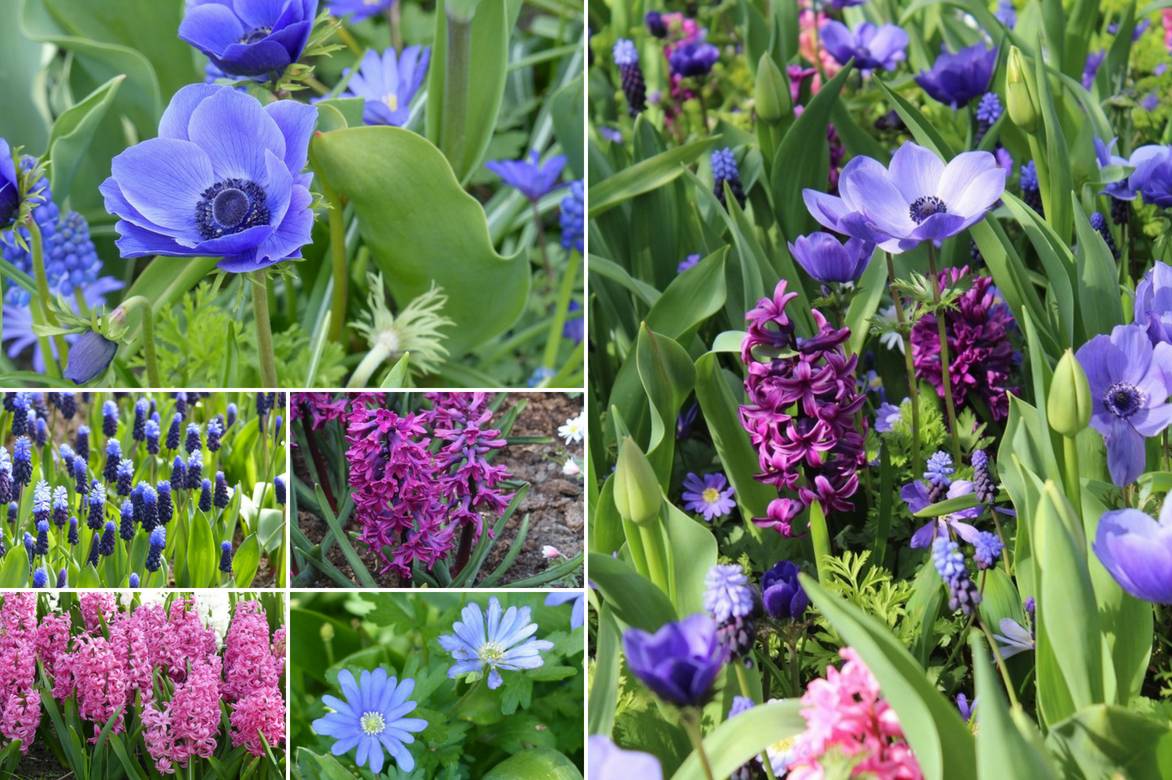
An example of pairing: Anemone coronarius, Muscari latifolium, Hyacinthus ‘Woodstock’, Hyacinthus ‘Pink Pearl’, Anemone blanda ‘Blue Shades’.
Did you know?
Hyacinth flowers are edible. In the past, they were crystallised in sugar to create a highly prized confection known as “Constantinople hyacinth preserve.” They can be consumed raw or cooked. Here are some recipe ideas provided by the flower fairy workshop.
Useful resources
- Our Depth Guide for Spring Bulbs
- Discover our range of hyacinths!
- Advice sheet: Which bulbs to grow indoors?
- Advice sheet: Bulb Size: Understanding to Choose Better
- Advice sheet: Christmas Hyacinth: How to Force and Make it Bloom? and our tutorial: How to Force a Hyacinth in a Vase?
- Advice sheet: Planting Hyacinths: Our Tips for Installing Them in the Garden or in Pots
- Advice sheet: How to Choose a Hyacinth?
- Discover our ideas to combine Hyacinths in the garden, in pots or in bouquets
- Our advice sheet: 9 Blue Flower Bulbs You Must Have in Your Garden
- Our advice sheet: 7 Toxic Bulbs
- The hyacinth blooms for quite a long time! Discover other bulbs in Adopt These Long-Flowering Bulbs!
Frequently asked questions
-
I was given hyacinths in vases and I would like to know if I need to change the water in the vases.
There is no need to change the water; just maintain the level, ensuring that the bulb remains out of the water.
-
I have three large hyacinths in flower pots for indoors and the spikes are collapsing! Should I stake them?
The numerous flowers can destabilise the plant, so it is sufficient to stake it to prevent this. You can also use a tall vase whose walls will support the hyacinths.
-
How to store hyacinth bulbs?
When the foliage is a deep yellow, dig up the bulbs using a fork, taking care not to damage the bulbs. Shake off the soil and allow them to dry. Cut off the faded foliage. Store the bulbs in a crate or a wire basket lined with newspaper and keep them in a frost-free, dry, and well-ventilated place. You can plant your bulbs the following autumn.
- Subscribe!
- Contents
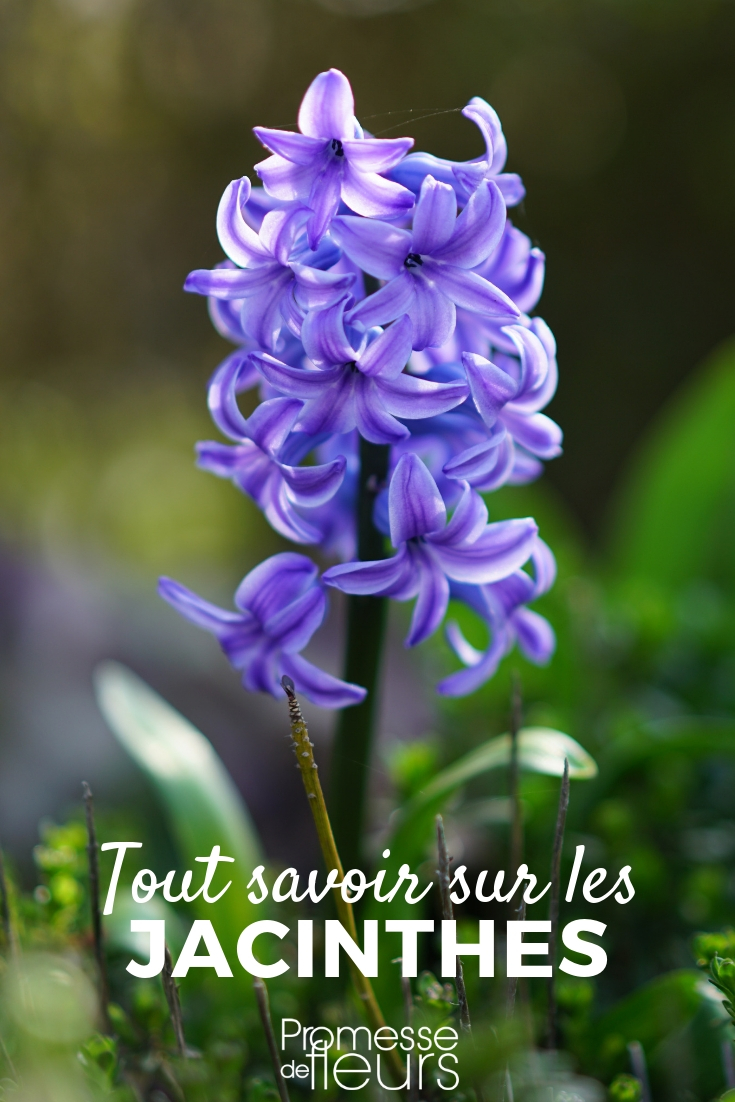































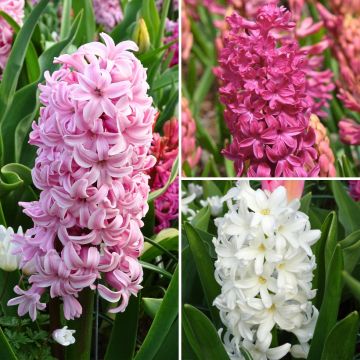
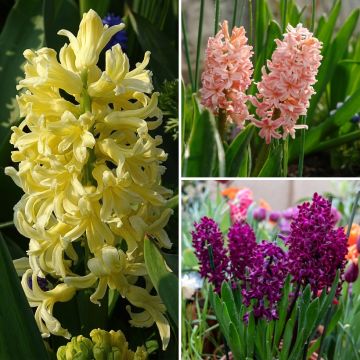
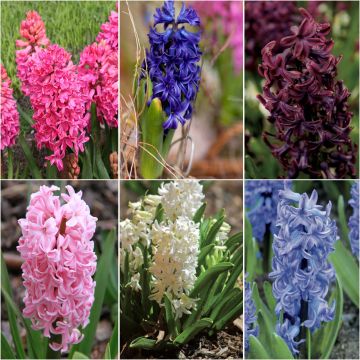

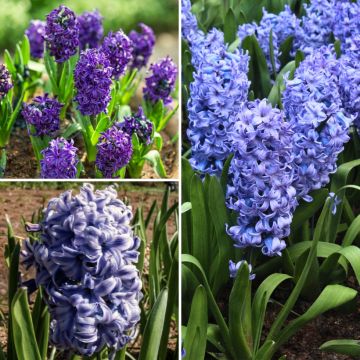

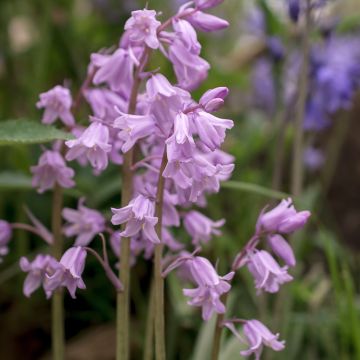
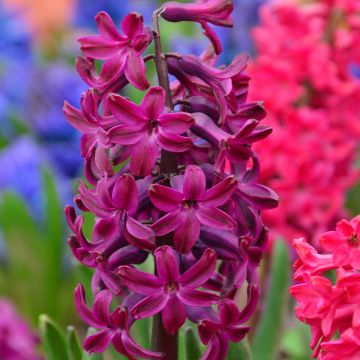

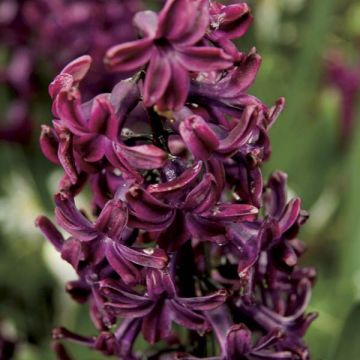
Comments